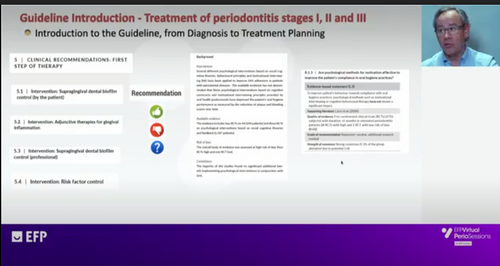![]()
11 December 2020
Mariano Sanz answers questions on EFP clinical practice guideline
Categories:Clinical Practice, Communication, New Classification

The importance of staging and grading cases of periodontitis, the re-evaluation of cases, the use of antibiotics, and whether it will be possible to develop a vaccine against periodontitis – these were among the questions put to Mariano Sanz by participants in his EFP Perio Sessions webinar which introduced Treatment of stage I-III periodontitis – The EFP S3-level clinical practice guideline.
Q: Why does staging and grading matter if the only treatment we have is scaling and root planing?
A: Subgingival instrumentation is the core treatment, and this core treatment always needs to be delivered in a periodontitis patient. But it is not the only treatment that will be delivered and, depending on the stage, we will need to implement other adjunctive therapies. For stage III or stage IV patients, for very deep probing depths, for grade 2 and 3 furcation lesions, for infrabony defects – subgingival instrumentation will not be enough. So, you will need to render beyond that. Staging is important to understand the complexity and the severity of your case, but the grading is important to understand what kind of patient you are delivering the therapy to.
Q: How long do you have to wait after Step 1 before starting Step 2?
A: It will depend on the patient. Imagine that I have a patient 50 years old who does not smoke, blood pressure is fine, no history of cardiovascular disease, no history of diabetes, BMI below 25, and after the first two appointments the patient has a plaque index below 10%. Why should you wait any longer? You could go directly into Step 2. However, if you have a patient the same age who has tons of calculus, has a plaque index of 90%, is overweight, obese, has all the risk factors, then you need time. You need to do a professional supragingival plaque elimination, you need to start with demonstrating the use of the toothbrush, continue with the floss and the interdental brush, try to manage their risk factors and this may take a month – three, four, or five appointments – before you can start with your subgingival instrumentation. Again, you need to use your clinical judgement, and you need to assess your patient.
Q: What about the re-evaluation time? When should the patient be revaluated after Step 2 or Step 3 of therapy?
A: We don’t have a precise time, but probably the longer you allow the tissues to heal the better. We always recommend never to re-evaluate before eight weeks after step 2. So, the idea is from two to six months, and it depends a lot on your patient’s plaque control and their ability to maintain a plaque-free environment. To give an example, if I have a stage III periodontitis patient with very deep pockets and I do subgingival instrumentation and my patient has less than 10% plaque control but still has deep bleeding sites, in those areas where there are still deep residual pockets, irrespective of whether you wait three months or four months or six months, you have not succeeded with your therapy. Your therapy is not going to heal more by waiting more. But there are many situations where you have intermediate probing depths, where the patient is improving, that you can reinstrument a little bit more and then you should wait. Sometimes it is worthwhile reinstrumenting. But it depends on whether you have three, four, or five residual pockets in a patient’s mouth or if you have 26.
But this is not a cooking recipe. This is something that you need to develop your own clinical judgement, your own clinical criteria.
Q: What about local antibiotics or systemic antibiotics for the treatment of periodontitis when needed?
A: The Guideline does not recommend the routine use of systemic antibiotics. I hardly ever use systemic antibiotics. I cannot say I would never use systemic antibiotics – there are very specific, highly susceptible patients where they may be appropriate. For example, if you have a patient who is 25 years old with extremely deep pockets but not so much plaque accumulation, you know that you have a very susceptible, early-onset periodontitis patient and the use of adjunctive antibiotics is probably justified. And for non-responders. If you do the subgingival instrumentation and if the patient has reasonable plaque control but at your re-evaluation you see that nothing has worked, then I would probably use systemic antibiotics. Local antibiotics have their role – but not in the treatment of periodontitis, they have their role during maintenance. If I have very isolated deep pockets, probably then there is a place for local antimicrobial application together with subgingival instrumentation – always as an adjunct, never as the only therapy.
Q: Is there any research in developing a vaccine for periodontitis? Could it be feasible?
A: There has been a lot of research. But the problem is that the more we know about the microbial complexity within the subgingival environment the less we think that a vaccine is the solution. There are millions of bacteria and we know of about 200 different species. We don’t even know how to name the other species, because we can only identify their DNA but we cannot identify their genera and their species because they have never been cultivated. With this complexity, I think it is ludicrous to look at one pathogen – porphyromonas gingivalis, for example – because if you prevent that from colonising, the others would overcome the threshold. So, with this complex disease, there is no avenue for a vaccine, at least in the short term.




